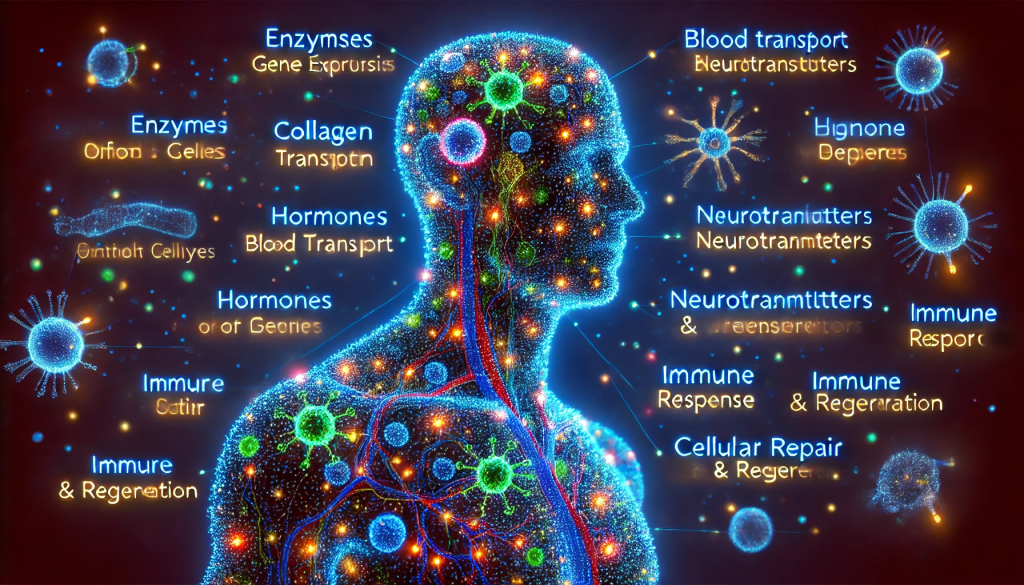The body produces proteins from genes through a process called gene expression. This process involves transcribing DNA into messenger RNA (mRNA) and then translating mRNA into proteins. Proteins are the building blocks of life and perform a vast array of functions within the body.

How Proteins Are Produce
Transcription: (see the video)
– The DNA sequence of a gene is copied into mRNA in the cell’s nucleus.
– This mRNA carries the genetic information from the DNA out of the nucleus and into the cytoplasm.
Translation
– The mRNA is read by ribosomes, cellular structures that translate the mRNA sequence into a chain of amino acids.
– Transfer RNA (tRNA) molecules bring the appropriate amino acids to the ribosome, which assembles them into a protein based on the sequence encoded in the mRNA.
Protein Folding and Modification:
– Once synthesized, the protein folds into a specific three-dimensional shape, which is crucial for its function.
– Some proteins may undergo further modifications, such as the addition of carbohydrate groups, phosphorylation, or cleavage, to become fully functional.
Types of Proteins Produced by the Body:
The body produces thousands of different proteins, each with a specific function. Here are some major categories:
1. Structural Proteins:
– Collagen: Provides structural support to skin, bones, tendons, and other connective tissues.
– Keratin: Found in hair, nails, and the outer layer of skin, providing protection and strength.
2. Enzymes
– Amylase: Breaks down starches into sugars during digestion.
– DNA Polymerase: Involved in DNA replication, ensuring genetic information is accurately copied.
3. Transport Proteins:
– Hemoglobin:Transports oxygen from the lungs to tissues throughout the body.
– Albumin:Helps maintain blood pressure and transports hormones, vitamins, and drugs through the bloodstream.
4. Signaling Proteins:
– Insulin: Regulates blood glucose levels by signaling cells to take up glucose.
– Growth Hormone: Stimulates growth, cell reproduction, and regeneration.
5. Defensive Proteins:
– Antibodies: Produced by the immune system to identify and neutralize pathogens like bacteria and viruses.
– Complement Proteins: Work with antibodies to destroy pathogens.
6. Motor Proteins:
– Myosin: Involved in muscle contraction and movement.
– Dynein: Transports cellular cargo along microtubules within cells.
7. Storage Proteins:
– Ferritin:Stores and releases iron in the body.
– Casein:Found in milk, providing a source of amino acids and calcium.
8. Regulatory Proteins:
– Transcription Factors:Bind to specific DNA sequences to regulate the expression of certain genes.
– Hormones: Regulate various physiological processes, such as metabolism, growth, and mood.
Examples of Specific Proteins:
– P53: A tumor suppressor protein that regulates the cell cycle and helps prevent cancer.
– Cytokines: Small proteins released by cells that have a specific effect on the interactions and communications between cells, particularly in the immune system.
– Actin and Myosin: Work together in muscle contraction and cellular movement.
– Glucagon: Raises blood glucose levels, opposite to the function of insulin.
Summary:
The body produces a vast array of proteins from genes, each with specific and crucial roles in maintaining life and health. These proteins range from those that build and maintain body structures to those that regulate biochemical processes, fight infections, and transport molecules. The diversity and specialization of these proteins are essential for the proper functioning of the body.
Why Gene Expression cannot express properly? What are the causes?
Gene expression may not function as expected due to several factors, which can disrupt the process of turning genetic information into functional proteins. Possible causes include:
- Genetic Mutations:Mutations in the DNA sequence can interfere with the normal transcription and translation processes, leading to faulty or incomplete protein synthesis. occur when there are changes in the DNA sequence. For instance, a mutation in the CFTR gene can lead to cystic fibrosis. This condition arises due to the deletion of three DNA bases, which results in the production of a malfunctioning protein that affects the lungs and digestive system.
- Epigenetic Changes:Modifications like DNA methylation or histone acetylation can affect gene accessibility and expression without altering the DNA sequence.
- Environmental Factors:Exposure to toxins, pollutants, or radiation can impact gene expression by damaging DNA or altering regulatory pathways.
- Regulatory Issues:Malfunction in transcription factors or RNA polymerase can prevent proper activation or repression of genes.
- Post-Transcriptional Errors:Mistakes during RNA processing, such as splicing errors, can result in nonfunctional or altered proteins.
- Cellular Stress: Conditions like oxidative stress, nutrient deprivation, or infections can disrupt normal gene expression patterns.
- Protein Misfolding: Errors during protein folding or modification can render proteins nonfunctional, even if gene expression itself was successful.
- Inherited Disorders: Certain genetic conditions can impair the mechanisms that regulate or execute gene expression.
Understanding the Electron-Free Radicals
The main function of electrons inside the cell is to facilitate biochemical reactions, primarily through the processes of energy transfer and chemical bonding. Electrons play a crucial role in several vital cellular functions, including:
. Energy Production (Cellular Respiration
– Electron Transport Chain (ETC): In the mitochondria, electrons are transferred through a series of protein complexes known as the electron transport chain. This transfer of electrons is part of oxidative phosphorylation, the primary method by which cells produce ATP (adenosine triphosphate), the main energy currency of the cell.
– ATP Synthesis: As electrons move through the ETC, they help pump protons across the inner mitochondrial membrane, creating a proton gradient. This gradient powers ATP synthase, an enzyme that synthesizes ATP from ADP (adenosine diphosphate).
Redox Reactions
– Electrons participate in oxidation-reduction (redox) reactions, where one molecule loses electrons (oxidation) and another gains electrons (reduction). These reactions are essential for metabolism, detoxification, and cellular signaling.
– NADH and FADH2: These are electron carriers that transport electrons to the ETC. They are generated during glycolysis and the Krebs cycle and play a critical role in energy production.
Chemical Bonding
– Electrons are involved in forming chemical bonds, including covalent bonds that hold atoms together in molecules. The sharing of electrons between atoms creates the stable molecular structures necessary for life, such as DNA, proteins, and cell membranes.
Signaling
– Electrons can influence cell signaling pathways, particularly through the generation of reactive oxygen species (ROS). Small, controlled amounts of ROS can act as signaling molecules that regulate processes like inflammation, cell growth, and apoptosis (programmed cell death).
Impact of Unpaired Electrons (Free Radicals) on Health
When electrons become unpaired, they can form free radicals, which are highly reactive and unstable molecules. Free radicals can damage cells, proteins, DNA, and lipids, leading to oxidative stress. Here’s how free radicals can affect health:
1. Oxidative Stress: This occurs when there is an imbalance between free radicals and antioxidants in the body. Oxidative stress can lead to cellular damage, contributing to aging and various diseases, including cancer, cardiovascular diseases, diabetes, and neurodegenerative disorders like Alzheimer’s and Parkinson’s diseases.
2. DNA Damage**: Free radicals can cause mutations by damaging the DNA in cells. If not repaired, this DNA damage can lead to cancer and other genetic disorders.
3. Lipid Peroxidation: Free radicals can attack lipids in cell membranes, leading to lipid peroxidation. This damages cell membranes, affects their integrity, and can lead to cell death.
4. Protein Damage: Free radicals can oxidize proteins, altering their structure and function. This can impair enzyme activity and disrupt cellular processes.
Antioxidants: The Defense Mechanism
– The body uses antioxidants to neutralize free radicals and minimize their damage. Antioxidants donate an electron to free radicals, stabilizing them and preventing them from causing harm.
– Common antioxidants include vitamins C and E, glutathione, and enzymes like superoxide dismutase (SOD) and catalase. A diet rich in fruits and vegetables provides antioxidants that help combat oxidative stress.
Conclusion
Electrons are fundamental to cellular function, playing key roles in energy production, chemical reactions, and signaling. When electrons become unpaired, forming free radicals, they can lead to oxidative stress and cellular damage, potentially contributing to aging and various diseases. The body’s antioxidant defenses are crucial for maintaining the balance and protecting against the harmful effects of free radicals. Maintaining this balance is important for overall health and well-being.

Leave a Reply